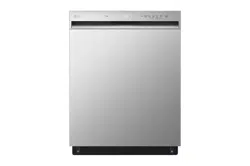Documents: Go to download!
User Manual
- Owner's manual - (English)
- PRODUCT OVERVIEW
- OPERATION
- SMART FUNCTIONS
- MAINTENANCE
- TROUBLESHOOTING
Table of contents
OWNER'S MANUAL Dishwasher
PRODUCT OVERVIEW
Product Features
- The images in this guide may be different from the actual components and accessories, which are subject to change by the manufacturer without prior notice for product improvement purposes.
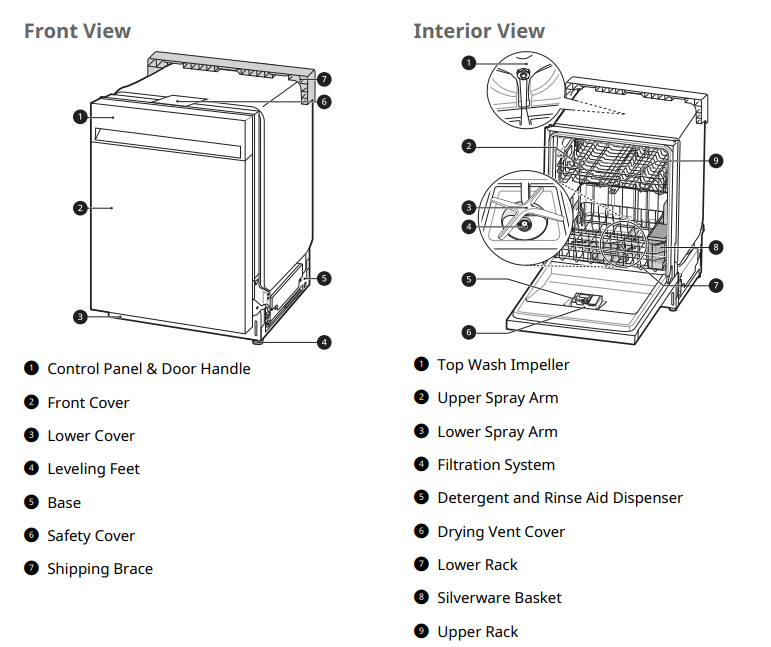
NOTE
- Remove all packing materials from the exterior and interior of the dishwasher before installing the appliance.
- Press the tab to remove the cable tie by hand. Cutting the tie with a knife or scissors may damage the rack or the silverware basket.

Product Specifications
The appearance and specifications listed in this manual may vary due to constant product improvements.
| Model | LDFN343** |
| Electrical Requirements | 120 V, 60 Hz AC only, minimum 15 A circuit breaker |
| Min. / Max. Water Pressure | 20 psi - 80 psi (140 kPa - 550 kPa) |
| Dimensions (Width X Depth X Height) | 23 3/4” X 24 5/8” X 33 5/8” (603 mm X 625 mm X 854 mm) |
| Inlet Water Temperature | 120 °F (49 °C) minimum, 149 °F (65 °C) maximum |
| Net Weight | 70 lbs. (31.8 kg) |
OPERATION
Before Using
Quick Start
- Load the dishes.
- Pull each rack out and load the dishes as described in this manual.
- Only load items that are dishwasher-safe.
- Scrape the dishes free of excess food, bones, and any other hard, non-soluble residue. Remove solid, burned-on scraps from dishes prior to loading in the dishwasher.
- Place items with deep dish bottoms at an angle to help water run off and speed the drying process.
- Do not load items that are not heatresistant or have decorative metal trim.
- Measure the detergent.
- Using the guidelines in this manual, fill the detergent cup with the recommended amount of detergent and close the lid. If a prewash is desired, the recess on top of the lid should also be filled with detergent.
- Close the door.
- Turn on the dishwasher.
- To turn on the display panel, press the Power button.
- Check the rinse aid.
- The Rinse Aid e icon will flash if the level of rinse aid in the dishwasher is low. Add rinse aid if the level is low to maintain the effectiveness of the dry cycle.
- Select the cycle and options.
- Select the cycle and options that best fit the load by referring to the Cycle Guide. The display will show the estimated time for the cycle and options selected.
- Operate the dishwasher.
- Method 1 - Press the Start button and then close the door in less than four seconds to operate the dishwasher. If the door is not closed within four seconds, the white LED with time flashes, an audible tone is heard, and the cycle does not start.
- Method 2 - Close the door first and then press the Start button to operate the dishwasher.
- End of cycle.
- When the cycle is complete, a chime will sound and the display will show ENd until the door is opened or Power is pressed. To save energy, press and hold High Temp for three seconds to set the ENd display to automatically turn off a few minutes after the cycle ends.
Auto-Off
- The dishwasher automatically turns off after four minutes of inactivity if paused or if no cycle is started.
Control Panel
Control Panel Features

1 Power On/Off Button
- Press this button to turn the washer on or off.
- If there is a power surge, power outage, or disruption of any kind, power is automatically turned off for safety.
- When power is connected again, the dishwasher will turn on automatically and resume the cycle.
2 Display
 : Rinse Aid Icon
: Rinse Aid Icon
- This icon illuminates when the rinse aid level is low. The LED automatically shuts off when the rinse aid is refilled or the level is set to 0.
- Refer to the Rinse Aid Dispenser Adjustment section.
 : Digital Display
: Digital Display
- The digital display on the control panel shows the ESTIMATED cycle time. When the cycle and options are selected, the display shows the total estimated time to complete those selections. During operation, the display shows the remaining estimated operating time.
 ,
,  Control Lock
Control Lock-
- The Control Lock feature helps prevent settings from being changed during a cycle. Selecting this feature locks all of the buttons, except for the Power button, on the control panel. This feature does not lock the door.
- While a cycle is running, press and hold Flex Zone and High Temp. simultaneously for three seconds to activate or deactivate Control Lock.
- To start a new cycle, deactivate Control Lock.
 : Machine Clean
: Machine Clean
- The Machine Clean icon flashes every 30 cycles. To activate or deactivate the icon, press and hold the Machine Clean and Flex Zone buttons for three seconds.
- If the High Temp. option is added to a cycle, the Machine Clean icon stays lit at the end of the cycle if the dishes were properly sanitized.
 : Night Dry
: Night Dry
- This indicator lights up when Night Dry is selected.
3 Chime On/Off Button
- To activate or deactivate the button sounds, press and hold Cycles and Machine Clean simultaneously for three seconds. The error alert sound cannot be turned off.
4 Cancel Button
- The drain pump activates and the cycle cancels. Once the dishwasher finishes draining, the power turns off.
- Press and hold Start for three seconds to activate.
5 Start Button
- To operate the machine, either press Start and close the door within four seconds or close the door and press Start.
- An alert will sound if the door is closed more than 4 seconds after the Start button is pressed.
Wash Cycles
Select your desired cycle.
Selecting the Cycle
- The default cycle is Auto. You can also customize these settings using the Cycles button.
- Press the Cycles button repeatedly to select the Normal, Heavy, or Turbo cycle.
- Auto: This cycle senses the soil amount and soil toughness and is optimized to achieve the best cleaning.
- Normal: This cycle is for moderately soiled, everyday loads. Select the Night Dry option if leaving dishes overnight. Press and hold Extra Dry for three seconds to activate Night Dry.
- After the cycle ends, the fan runs for an hour to help vent the warm, moist air in the tub. You can stop the fan by opening the door after the cycle ends.
- Heavy: This cycle is for heavily soiled dishes and dishes with hardened on soil. This cycle defaults to the strongest spray intensity and uses it to wash heavily soiled dishes.
- Turbo: This cycle will clean heavily soiled dishes in an hour using slightly more energy and water.
- This cycle does not have drying. Select the Extra Dry and Night Dry option or another cycle for better drying.
Machine Clean
- This cycle is for cleaning the inside of the dishwasher. Use the cycle without dishes in the machine. It eliminates residual soils, odor, white spots, and other dirt. Add citric acid or another cleaning agent for more effective results.
Options and Extra Functions
Select the desired cycle button and then select the options for that cycle.
Using the Flexible Zone
- This option adjusts the wash intensity to target different zones inside the dishwasher. Set it to wash just the upper rack or lower rack, or set the intensity to soft for the upper spray arm and strong for the lower spray arm.
- The Flex Zone is off by default. Press the Flex Zone button to customize settings.
- Press the Flex Zone button repeatedly to select the 4 modes for cleaning the dishes.
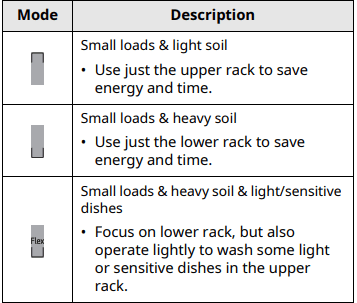
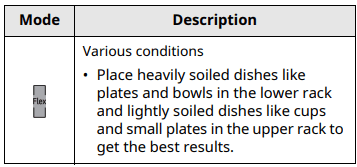
- High Temp: Raises the main wash temperature to improve cleaning.
- Extra Dry: Select the Extra Dry option for better drying performance. This option adds extra drying time to the cycle and raises the heated rinse temperature.
- When the rinse aid is empty, the Extra Dry option is selected automatically
- Night Dry: Dishes are often left in the dishwasher overnight after the cycle ends. This can result in the steam inside the tub condensing on dishes, leaving them wet. This option runs the ventilation fan periodically to help vent the steam from the tub.
- Press and hold Extra Dry for three seconds to activate.
- The Night Dry option is selected by default for all cycles for which it is available, except the Normal cycle.
- To add the Night Dry option to the Normal cycle, press and hold Extra Dry for 3 seconds.
- Delay Start: This feature delays the start of a selected cycle. Each time the Delay Start button is pressed, the delay time increases by an hour. The delay time can be set from 1 to 12 hours, in one-hour increments.
Cycle/Option Guide
The cycle guide below shows the available options for each cycle.
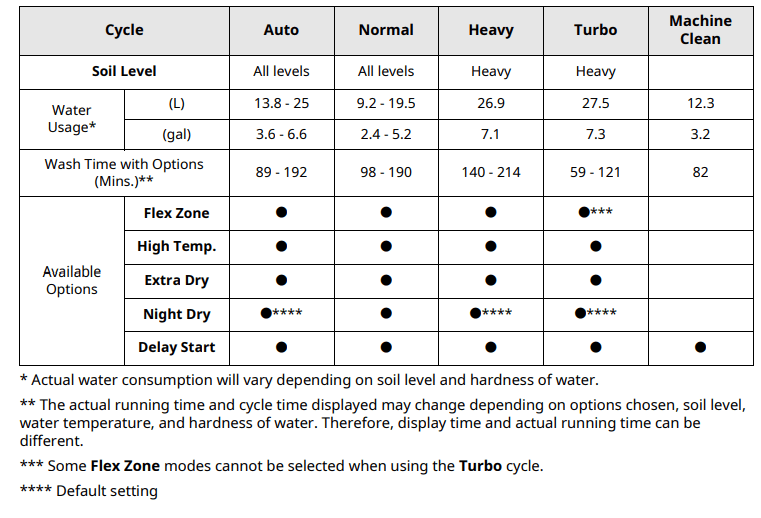
Loading the Dishwasher
The extra tall tub allows loading of dishes, pans, or other utensils up to 14" high. For effective washing performance, always follow these instructions.
- Remove large particles of food debris from plates including bones before loading.
- Items with burnt on food should be soaked prior to loading in the dishwasher.
- Deep pots or dishes should be placed upside down.
- Make sure that all items do not touch each other.
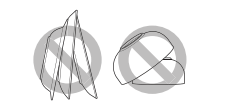
Non-Dishwasher Safe Items: The combination of high water temperature and dishwasher detergents may damage certain items. Do not wash the following items in the dishwasher.
- Copper or anodised aluminum
- Hand painted silver or gold leaf china
- Wood or bone handled utensils
- Iron or non-rustproof utensils
- Plastic items which are not dishwasher safe
- Sterling silver or gold-plated flatware or delicate or metal-rimmed china
- Fragile items such as crystal glasses
Loading the Silverware Basket
The silverware basket has separators to avoid scratching and tarnishing of delicate silverware.
Loading Silverware into the Basket
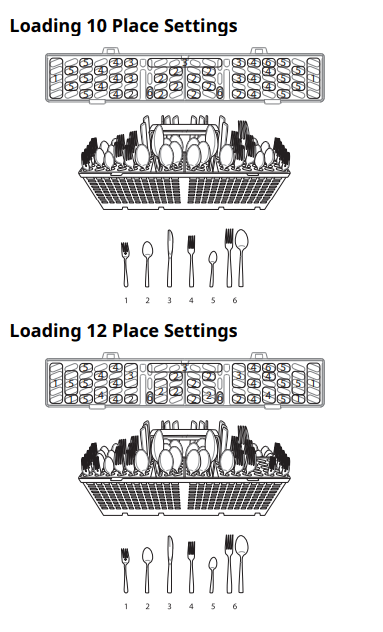
Silverware Loading Tips:
- For best cleaning results, use the top separators in the basket when loading silverware. The separators will prevent nesting of silverware.
- Load sharp items, such as knives, pointing down.
- When unloading the dishwasher, it is best to start with the silverware basket. Doing so will prevent water droplets from falling on your silverware from the upper rack.
Loading the Lower Rack
Loading Dishes into the Lower Rack

Lower Rack Loading Tips:
- Plates should be positioned upright and facing the center of the rack, and pots, pans and large dishes must be turned upside down.
- Load dinner plates, dishes, soup bowls, etc. between the tines.
- Load cookie sheets, cake pans and other large items at the sides or back of the rack. Loading these items in the front of the dishwasher can prevent the water spray from reaching the detergent dispenser.
- Make sure that pot handles and other large items do not stop the rotation of the spray arms.
- The lower rack should not be used for small items such as cups, wine glasses, or small plates. These items should be loaded in the upper rack.
- Make sure that large items do not interfere with the rotation of the spray arms, and do not prevent the detergent dispenser from opening.
Folding Down the Lower Tines
- Fold tines down to fit larger dishes; pull tines back up to fit smaller dishes.
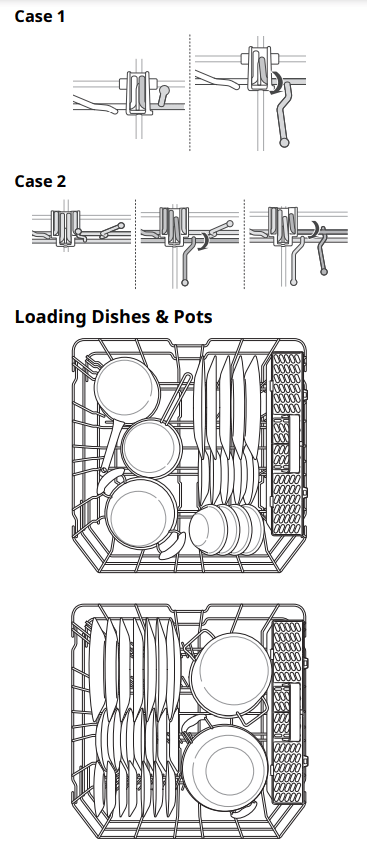
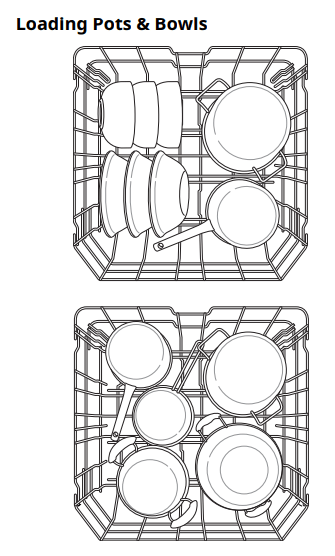
NOTE
- The silverware basket ships installed at the back of the bottom rack. For best performance, install it along the right side as shown
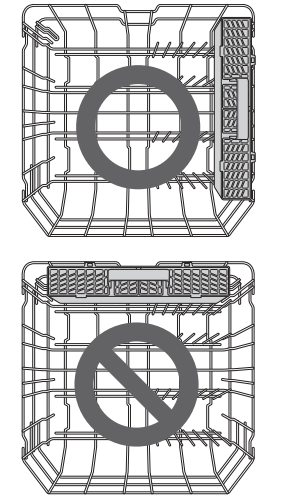
Loading the Upper Rack
Loading Dishes into the Upper Rack
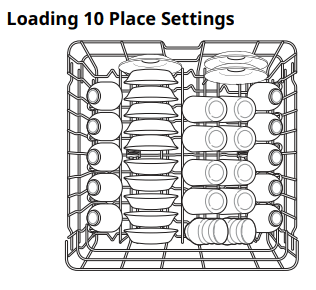

Upper Rack Loading Tips:
- Place cups and glasses in the rows between the rack tines. Placing them over the rack tines can lead to breakage and water spots.
- To avoid chipping, do not let stemware touch other items.
- Place items so that the open end faces down for cleaning and drying.
- Do not stack items on top of each other.
- Use the upper rack for small or delicate items such as small plates, cups, saucers, glasses, and dishwasher-safe plastic items.
- Cups, glasses, and bowls must be positioned upside down.
- Make sure items do not interfere with the rotation of the spray arms above and below the upper rack.
- When loading larger items in the upper rack, such as wine glasses or taller cups, it may be necessary to remove the cutlery rack if one is present.
Folding Down the Upper Tines
- Fold tines down to fit larger dishes; pull tines back up to fit smaller dishes.
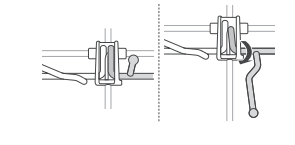
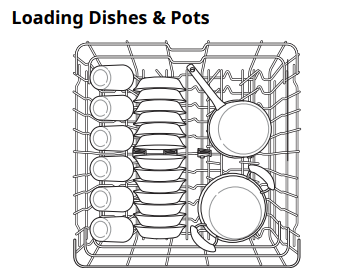
Height Adjustable Upper Rack
- The upper rack adjusts up and down. Raise the upper rack to allow items up to 14" tall in the lower rack. Lower the upper rack to allow dishes up to 12" tall in the upper rack. The dishwasher ships with the upper rack raised.
- There are two available positions for adjusting the height of the upper rack to create more space
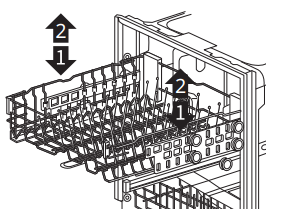
NOTE
- Before pushing the upper rack into the dishwasher, ensure the rack height is the same on both sides. If the height is not the same on both sides, the dishwasher door will not shut and the upper spray arm will not connect to the water inlet.
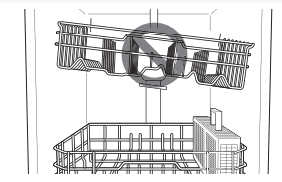
- There is a 2 5/8 inches (56 mm) gain in height when the upper rack is moved to the lower position.
- After adjusting the rack levels, check that the spray arms are free to rotate.
- When the upper rack is in the lower position, make sure the rack and the spray arm do not hit the items on the lower rack.
- When the upper rack is in the lower position, push in the upper rack first, and the lower rack later.
- Pull out the lower rack first, and the upper rack later.
Lowering or Raising the Rack
- Pull the rack to the front and completely remove it from the rail, then reinsert it at the desired height
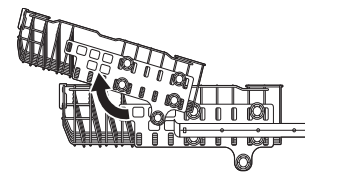
Possible plate size according to the upper rack position

Adding Cleaning Products
Adding Detergent to the Dispenser
- Remove the label on the dispenser prior to running the dishwasher for the first time.
- The amount of detergent needed depends on the cycle, load size, and soil level of dishes.
- Put detergent into the detergent compartment before starting any cycle, except the Rinse cycle.
WARNING: Dishwasher detergent and rinse aid contain chemical components, like all other household detergent. So, they must be kept out of the reach of children.
CAUTION
- Use only detergent intended for dishwashers. Incorrect detergent may cause the dishwasher to fill with suds during operation. Excess suds may reduce wash performance and may cause the dishwasher to leak.
- To avoid damaging the dispenser, do not pull up on the dispenser to close the dishwasher door
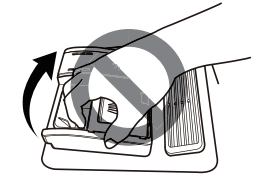
NOTE
- After completion of the wash program, check whether the detergent was completely washed out.
- Some dishwasher detergent tablets may become stuck in the dispenser due to their excessive size. Tablets can be placed onto the base of the wash tub next to the filter before starting the cycle.
- Too much detergent can leave a film on dishes and in the dishwasher, resulting in poor wash performance.
- If dishwasher detergent tablets are used without liquid rinse aid, the dishes and dishwasher interior will have excessive moisture. Select the Extra Dry option for better drying performance.
- Using liquid rinse aid improves drying performance by allowing water to drain off of dishes after the final rinse.
- Do not use detergent tablets for shorter wash cycles. The tablet may not dissolve completely, causing detergent residue on dishes and inefficient cleaning.
- Using a wash booster helps remove spots, residue, and the white film caused by hard water. It does not help remove excess detergent residue.
1 Push the button on the dispenser lid to open the cover.
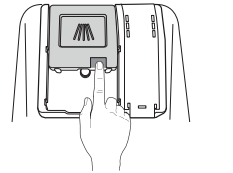
2 Add dishwashing detergent to the main wash compartment until the level is between the lines marked 15 and 25.
- Fill to over the 25 line for hard water or heavily soiled loads.
- Fill to the 15 line for soft water or lightly soiled loads.

3 Slide the detergent lid closed until it clicks
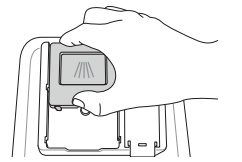
4 If a prewash is desired, fill the recessed prewash compartment area on the lid with detergent.
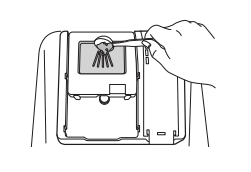
Adding Rinse Aid to the Dispenser
- The Rinse Aid
 icon appears in the display when more rinse aid is needed.
icon appears in the display when more rinse aid is needed. - The use of rinse aid is recommended to prevent water spots on dishes and to enhance drying performance.
1 Open the rinse aid lid by lifting up the flap.
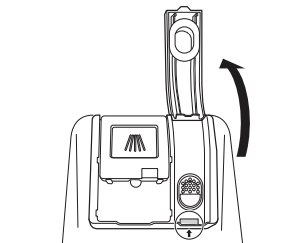
2 Add a liquid rinse aid to the maximum fill level. Allow the rinse aid to settle in the dispenser while filling, or air bubbles may result in poor drying performance. Avoid overfilling the dispenser

3 Close the lid to lock the dispenser. Rinse aid is dispensed automatically during the final rinse cycle.

Rinse Aid Dispenser Adjustment: The dispenser has five adjustment levels. The dishwasher is programmed at the factory for a rinse aid dispenser level of 2. This can be checked and adjusted from the control panel.
- Ensure the appliance is off.
- Press Power and Delay Start simultaneously to check the current setting.
- Press Delay Start to change the rinse aid dispenser setting. Each press of the button changes the setting one step from L0 to L4.
- Once the desired rinse aid dispenser setting is selected, press Start to save.
Refilling the Rinse Aid: How often the dispenser needs to be refilled depends on how often dishes are washed and the rinse aid setting used.
- The Rinse Aid
 icon flashes when more rinse aid is needed, unless the rinse aid dispenser setting is set to L0.
icon flashes when more rinse aid is needed, unless the rinse aid dispenser setting is set to L0.
SMART FUNCTIONS
LG ThinQ Application
- The LG ThinQ application allows you to communicate with the appliance using a smartphone.
- LG ThinQ Application Features
- Smart Diagnosis - This function provides useful information for diagnosing and solving issues with the appliance based on the pattern of use.
- Installing the LG ThinQ Application
- Search for the LG ThinQ application from the Google Play Store or Apple App Store on a smartphone. Follow instructions to download and install the application.
Smart DiagnosisTM Function
Use this feature to help you diagnose and solve problems with your appliance.
NOTE
- For reasons not attributable to LGE’s negligence, the service may not operate due to external factors such as, but not limited to, Wi-Fi unavailability, Wi-Fi disconnection, local app store policy, or app unavailability.
- The feature may be subject to change without prior notice and may have a different form depending on where you are located.
Using Audible Diagnosis to Diagnose Issues: Follow the instructions below to use the audible diagnosis method.
- Launch the LG ThinQ application and select the Smart Diagnosis feature in the menu. Follow the instructions for audible diagnosis provided in the LG ThinQ application.
- Press the POWER button to turn on the appliance.
- Do not press any other buttons.
- Place the mouthpiece of your smartphone close to the
 logo.
logo. 
- Press and hold the Delay Start button for 3 seconds or longer while holding the smartphone mouthpiece to the logo until the data transfer is complete.
- Keep the smartphone in place until the data transfer has finished. Time remaining for data transfer is displayed.
- After the data transfer is complete, the diagnosis will be displayed in the application.
NOTE: For best results, do not move the smartphone while the tones are being transmitted.
MAINTENANCE
To maintain performance and prevent trouble, it is important to check the outside and inside of the dishwasher, including filters and spray arms, at regular intervals.
WARNING
- When cleaning the outside and inside of the dishwasher, do not use benzene or thinner. Otherwise, it may cause fire or explosion.
- To prevent injury during care and maintenance or cleaning, wear gloves and/or protective clothing.
Cleaning and Care
Cleaning the Exterior
- In most cases, the exterior of the dishwasher can be cleaned with a soft damp cloth or sponge, then dried with a soft cloth. If the dishwasher has a stainless steel exterior, use a stainless steel cleaner.
- CAUTION: If cooking oil is spilled on the exterior of the product, wipe it off immediately. Do not clean the exterior of the product with cleaners which contain alcohol, thinners, bleach, benzene, flammable liquids, or abrasives. These substances may discolor or damage the appliance.
Cleaning the Interior
- Clean the interior of the dishwasher periodically with a soft, damp cloth or sponge to remove food and dirt particles.
- To remove white spots and odor from inside the dishwasher, run an empty cycle, without detergent, with one cup of white vinegar in a dishwasher safe glass or bowl placed on the upper rack. (Vinegar is an acid and with constant use it could damage the appliance.)
NOTE
- Run the Machine Clean cycle once a month, or more often if needed, to remove detergent buildup and other residue.
- If you have not used the dishwasher for a long time, refresh the inside by running the Machine Clean cycle without detergent. When the cycle is finished, clean the inside and outside of the dishwasher according to the MAINTENANCE instructions.
Clogged Drain Air Gap or In-Sink Disposal
Check the drain air gap or in-sink disposal if the dishwasher is not draining well.
NOTE
- The drain air gap and disposal are external plumbing devices that are not part of the dishwasher.
- The warranty provided with the dishwasher does not cover service costs directly associated with the cleaning or repair of the external drain air gap and disposal.
Cleaning the Air Gap
1 Turn off the dishwasher.
2 Remove the air gap cover and the plastic cap underneath it.

3 Clean out any debris with a toothpick or brush.
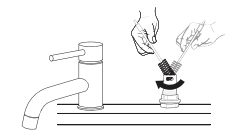
4 Replace the plastic cap and air gap cover.
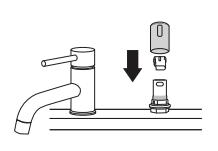
Cleaning the Filters
WARNING: Be cautious of sharp edges when handling the stainless steel filter.
CAUTION: Remove food residue caught in filters to prevent the buildup of odor-causing bacteria and possible drainage problems.
NOTE: For best wash performance, clean the filter after each load. If food debris remains in the filter, it may cause an odor. In areas with hard water, clean the filter at least once a month with a soft brush. Clean the filters using non-abrasive materials and warm running water
1 Remove the lower rack and position the bottom spray arm so a wider vee is open to the front.
2 Turn the inner filter counter-clockwise and take out the assembled inner filter and stainless steel filter. With the filters removed, check the sump opening and remove any foreign materials, if needed.

3 Clean the filters with a soft brush under running water. Reassemble the filters before reinstalling them.
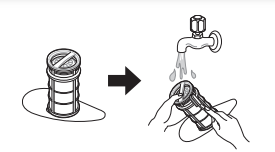
4 To replace the assembled filters, position the spray arm so the wider vee is toward the front. Fit the filters back into the filter holder and secure them by turning the inner filter clockwise until it clicks into place
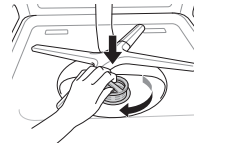
NOTE: Make sure the filter is assembled correctly before starting a cycle. When assembling, rotate the filter firmly until it clicks.

Cleaning the Spray Arm
- If the spray arm holes are blocked by any food residue, dishes may not be cleaned well due to improper water spray.
- It is recommended that the spray arms be cleaned once every two weeks.
Cleaning the Lower Spray Arm
1 Make sure that the water jet holes are not blocked by food particles.
2 If any food residue blocks the spray arm holes, remove it with a pin or any sharp tool.
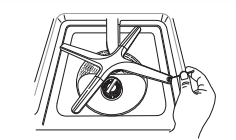
CAUTION: To avoid breaking the rolling spray arm
Cleaning the Upper Spray Arm
1 Pull the upper rack forward. Make sure that the water jet holes are not blocked by food particles.
2 When cleaning is necessary, remove the upper spray arm by turning the nut on the bottom of the spray arm 1/8 turn counterclockwise and pulling down.
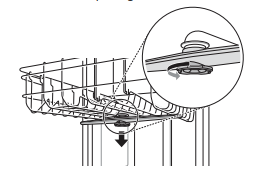
3 Remove food particles by rinsing or shaking the spray arm.
4 If any food residue blocks the spray arm holes, remove it with a pin or any sharp tool.
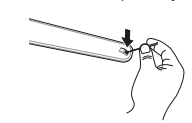
5 After removing the food residue, clean the spray arms under running water.
6 After cleaning the upper spray arm, press it up into place. Turn the nut 1/8 turn clockwise to make sure that the nut locks back into place.
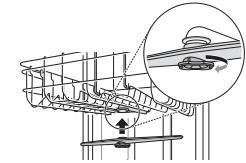
7 After assembly, make sure that the spray arms rotate freely.
Seasonal Maintenance and Storage
- If you will be absent for an extended period of time during warmer months, close the water valve and disconnect the power supply line, or turn off the circuit breaker. Clean the filter, tub and dispenser to prevent odor.
- If you will be absent for an extended period of time during colder months and there is a possibility of freezing temperatures, winterize the water supply lines and the dishwasher itself. Winterization must be performed by qualified service personnel.
TROUBLESHOOTING
he washer is equipped with an automatic error-monitoring system to detect and diagnose problems at an early stage. If the washer does not function properly or does not function at all, check the following before you call for service.
Before Calling for Service
FAQs
1. Q: Does this dishwasher require a rinse aid to be used?
- A: Rinse aid is strongly recommended to enhance the drying performance of the dishwasher. In order to be more energy efficient, the hybrid drying system does not use a heating element to assist in drying, so a rinse aid plays an integral role in the drying process. If a rinse aid is not used, water may remain on the dishes and the tub. Rinse aid helps to ensure that the majority of the water has been sheeted off of the dishes at the end of the rinse and that the load is ready for the dry cycle.
2. Q: What can be done if my dishes have a cloudy, white film on them after a wash?
- A: The cloudy film is usually caused by minerals in the water reacting with the dishwasher detergent. First, be certain not to use too much detergent. Refer to Adding Detergent to the Dispenser section for recommended detergent amounts. Add an extra rinse to the cycle. LG Dishwashers use less water than traditional dishwashers, so adding an extra rinse aids in rinsing the film away. If the water supply is hard, it may be necessary to add a performance booster that addresses the hard water condition.
3. Q: How do I remove white film on the tub?
- A: Measure 3 tbsp. (40 g) of citric acid powder and use it to fill the main detergent compartment. Run a Machine Clean cycle. Do not use detergent.
4. Q: What steps can I take to improve drying results?
- A: Drying performance is directly affected by the amount of heat that remains in the tub after the heated rinse is performed. If your dishwasher is far away from your home’s hot water heater, it may be necessary to run the hot water tap in the sink before starting a wash cycle, to ensure that cool water is purged from the hot water lines. This will ensure your dishwasher has a consistent supply of hot water from start to finish. Using the High Temp. setting also aids in keeping the inner drum temperature and dishes hotter before drying begins. LG dishwashers are designed to be used in conjunction with a rinse aid. Using a rinse aid will maximize the amount of water that has already been sheeted away from the dishes before the dry cycle begins. If a rinse aid is used and the performance still needs a boost, adjust the amount of rinse aid used. 2 is the default setting, but if necessary set the level to 3 so more rinse aid is used. Water tends to bead rather than sheet off plastic and nonstick surfaces, making them more difficult to dry. If washing plastic items in a Normal cycle, select the Extra Dry or Night Dry option or both for better drying results. When the rinse aid is empty, the Extra Dry option is selected automatically. Allow the dishwasher to completely finish the dry cycle before opening the door. If the door is opened in the middle of the dry cycle, the heat that is necessary for the hybrid dry system to work will escape. This will cause all of the dishes inside to remain wet once the cycle finishes.
5. Q: What is the hybrid drying system?
- A: The dishwasher does not rely on a heating element for the drying process; instead, it relies on the heat that is retained by the dishes and the tub during the wash and rinse cycles to turn the moisture in the tub into humidity. Warm, moist air in the dishwasher is then pulled into a condensing duct in the door by a fan. The air then cools, which causes the humidity to condense. Room temperature air is also drawn into the duct to help the air cool down faster. When this moisture condenses into a liquid, it is drained out.
- NOTE: Rinse aid is required to enhance the drying performance. If no rinse aid is used, water may remain on the dishes and the tub.
6. Q: Why am I hearing a whistling sound from the dishwasher?
- A: It is important to determine the duration of the noise and when it happens (what part of the cycle). When water is drawn into the dishwasher, a whistling noise can be heard. This is normal. If the water pressure is too high, it will be louder, so it may be necessary to adjust the water valve to lower the pressure if the noise is too loud.
7. Q: What kinds of dishes can be placed in the dishwasher?
- A: Ensure that the dishes you place in the dishwasher are dishwasher safe. Plastic dishware will not dry as effectively as glass and metal dishware. Plastic items do not retain heat as well as glass and metal dishware. Plastic cups and dishes may require some hand drying before being put away at the end of the cycle.
8. Q: Can I run a drain only cycle?
- A: To drain standing water, press and hold Start for three seconds until the cycle stops. Once the dishwasher finishes draining, the power turns off.
9. Q: Why does my dishwasher continuously chime if I open the door during a cycle or right after the cycle has finished?
- A: This is normal. The dishwasher is letting you know that the interior temperatures of the unit are hot and to use caution when reaching inside. Once the unit has cooled down, the chiming will stop.
10. Q: What is Control Lock and how is it activated?
- A: Control Lock is a feature that prevents the controls from being changed during the cycle. It does not prevent the door from being opened or the unit from being powered off. To activate or deactivate, press and hold Flex Zone and High Temp. simultaneously for three seconds.
11. Q: Can I add an extension to the drain hose? A: If a drain hose extension is required, use a 5/8" or 7/8" inside diameter, 2 ft ~ 3 ft. length hose and a coupler to connect the two hose ends.
12. Q: An LED is blinking, the machine is chiming, and the dishwasher won't start. What is wrong with the dishwasher?
- A: This is a safety feature. The door must be closed within four seconds of pressing the Start button. If the door is not closed within four seconds, an LED flashes, an audible alert sounds, and the dishwasher does not operate. To start the dishwasher, open the door and either close the door and press Start (front controls).
13. Q: Should I pre-rinse dishes before loading them?
- A: No, you don't need to pre-rinse the dishes before loading especially if using the Normal and Auto cycles. The dishwasher washes dishes clean without pre-rinsing.
User Support Videos
For further assistance, there are videos and tutorials available through the LG.com website.
- On the www.lg.com home page, click on the Support menu tab to bring up the menu selections. Select Video Tutorials.
- Select a product category and then pick a topic or search a keyword.
Error Messages
| Problem | Possible Cause & Solution |
 |
Water inlet problem.
|
 |
|
 |
Oversudsing caused by improper detergent, such as liquid dish soap.
Failure to level dishwasher.
|
 |
Water leakage
|
 |
Excessive Water supplied.
|
 |
Heater circuit failure.
|
 |
Thermistor failure.
|
 |
Motor trouble
|
 |
Vario motor trouble
|
 |
Test mode is selected.
|
 |
Rinse aid level setting mode is selected.
|
 |
Control Lock is activated.
|
Operation
| Problem | Possible Cause & Solution |
| Dishwasher will not operate |
|
| Dishwasher operates too long. |
Dishwasher is connected to cold water.
|
| Water remains in tub after completion of cycle. |
Drain hose is kinked or clogged.
|
| Noise |
Some level of noise is normal during operation.
The dishwasher is not level.
Nozzle arm knocking against dishes.
|
| Lights do not illuminate. |
Power is not connected.
|
| Spray arms do not rotate smoothly |
Holes of spray arms are blocked by food particles.
|
| Upper rack is crooked. |
Rack is poorly adjusted.
|
| Dishwasher continuously chimes when the door is opened, during or right after a cycle has completed |
This is a safety measure. Contact with escaping steam or the hot contents of the dishwasher could result in injury.
|
| Door does not close completely. |
Cutlery rack is not properly loaded.
|
| Dishwasher chimes if panel is touched during operation |
Bumping into or touching the control panel during operation may result in a disabled button sound. Only the Power, Start, and Control Lock buttons are enabled during operation to prevent cycle settings from being changed inadvertently.
|
| Dishwasher did not finish cycle. |
Door was opened during cycle.
|
| Leaking in front of appliance |
Dishwasher not leveled properly.
Wrong detergent used.
|
Performance
| Problem | Possible Cause & Solution |
| Odor |
The previous cycle was stopped before completion and residual water remains in the dishwasher.
There is food in the bottom of the appliance or in the filter.
Unwashed dishes are left in the appliance for a long time.
After cleaning, the appliance smells like detergent.
|
| Food soil remains on dishes |
Improper cycle selection.
Water temperature is too low.
Dishwashing detergent was not used.
Low inlet water pressure.
Water jet holes on spray arms blocked.
Improper loading of dishes.
Filters are clogged.
|
| Cloudiness on glassware |
Combination of excessive detergent and hard water.
|
| Black or gray marks on dishes. |
Aluminum items rubbing dishes during cycle.
|
| Yellow or brown film on inside surfaces of dishwasher |
Coffee or tea stains.
|
| Spots and filming on dishes. |
Low water temperature.
Overloading.
Insufficient water pressure.
Insufficient detergent.
Rinse aid dispenser is empty.
Hard water buildup in the tub.
|
| Dishes don’t dry. |
Rinse aid dispenser empty.
|
See other models: LRFWS2906D LRFWS2906S PH510P 49UT347H0UA LSN120HXV2
